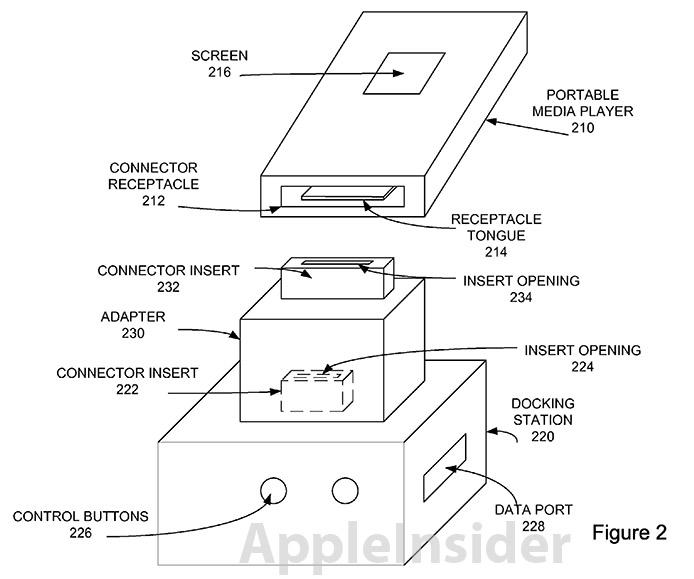Apple on Tuesday was awarded a patent covering a universal adapter for portable media players that affords, in one embodiment, the transmission of wireless data to any accessory, possibly providing a solution to complaints regarding the company's switch to the new Lightning connector.
When the iPhone 5 debuted last month, many longtime iDevice users bemoaned the new handset's Lightning port, as it effectively ended compatibility with nearly a decade's worth of accessories built for the legacy 30-pin standard.
Apple's U.S. Patent No. 8,280,465 for a "Wireless adapter for interfacing between an accessory and a device" could be an answer for owners who invested hundreds of dollars in 30-pin "Made for iDevice" products.
The IP itself is a continuation of a 2008 Apple patent application simply titled "Adapter," which describes how an apparatus can be used to provide compatibility between portable media players and accessories that were previously incompatible. While the older property is incorporated into the patent awarded on Tuesday, much of the invention has been rendered obsolete by advances in technology as well as Apple's decision to move to the smaller Lightning standard. What is still pertinent, however, is the wireless embodiment of the adapter which may one day give new life to legacy accessories incompatible with the smaller plug.
As described by the patent's background:
Users may have more than one type of media player. For example, a user may have a high-capacity portable media player for home use and a smaller, low-capacity portable media player for use at the gym.For various reasons, these media players may have different sized connectors. For example, the media players may be made by different manufacturers. Also, they may be made by one manufacturer, but a newer media player may have a more advanced, smaller sized connector receptacle.
The original invention was meant to skirt purchasing speakers or docks for each portable device a user owned, however the patent can now be adapted to solve the current issue of having rendered-obsolete accessories.
Apple notes that an accessory can either be physically incompatible with a portable device, as is the case with Lightning, or electrically incompatible, meaning it lacks proper power, signal or formatting support. To get around the physical incompatibility, the invention employs an adapter like those seen as recently as the various 30-pin units offering support for USB, HDMI and VGA in/out, among others.
Solving the signal issue, the patent calls for the adapter to carry on-board circuitry that can translate the source signal to one recognized by a given accessory. The same type of on-board solution also rectifies the power issue.
Wireless
As for wireless, Apple's patent describes an adapter "where one or more of these connector interfaces are replaced with wireless circuitry," offering the example of a wireless-enabled portable media player and an accessory that doesn't have such functionality.
Wireless embodiment of patented adapter.The patent provides for an adapter with a built-in wireless transmitter which can communicate signals "between the accessory and the portable media player," while another embodiment provides for the reverse. Also provided for is an incompatibility with wireless protocols, such as Bluetooth and Wi-Fi, both of which can be addressed by the adapter's internal circuitry.
Adapter bridging between two wireless-enabled devices.As for accessory authentication, wireless signals can be sent to a "Made for iDevice" product from an iPhone or iPod, allowing Apple to stymie third-party manufacturers attempting to build royalty-free products.
It is not yet known whether Apple will launch an adapter using the patent's inventions, though it seems such a device could solve the issue of accessory incompatibility for those concerned about making the jump to new-generation products with Lightning connectors.
The adapter patent was filed for in September 2011 and credits Jesse Dorogusker, Emily C. Schubert, Donald Ginsburg, Gregory T. Lydon and Lawrence G. Bolton as its inventors.
 Mikey Campbell
Mikey Campbell







-m.jpg)






 Thomas Sibilly
Thomas Sibilly
 Wesley Hilliard
Wesley Hilliard
 Marko Zivkovic
Marko Zivkovic

 Malcolm Owen
Malcolm Owen

 Amber Neely
Amber Neely










10 Comments
Not sure this will fly. It again opens up Apple to accusations of 'yet another proprietry adapter people are expected to buy to continue using their devices' Also on first reading, I thought it was all about AirPlay rather than some new method, but then, my understanding of Patent Speak is wanting.
Even if Apple does make a wireless adapter for 30-pin to Lightning connections, it definitely wont be cheaper than the wired adapter. Though it might help guys with speaker docks.
This wireless adaptor is much needed by some; but not all. Those who have an old accessory device where there isn't room for the other plugs; this will do the job.
I applaud Apple for coming out with this to help ease the transition from old to new size adaptors.
"
So "wirelessly" becomes the new "with a computer" or "on the Internet"? I see the value in being able to go from one device to a legacy port via a wireless connection, but _I_ don't find it novel enough to patent - but then I'm not a patent lawyer. One could say AirPlay is a wireless adapter that goes from a device to an HDMI signal. Or wireless speakers are an adapter that use Bluetooth or Wi-Fi.
I understand the application, but I don't see how it's novel when compared with all the existing applications of Bluetooth and Wi-Fi.
- Jasen.